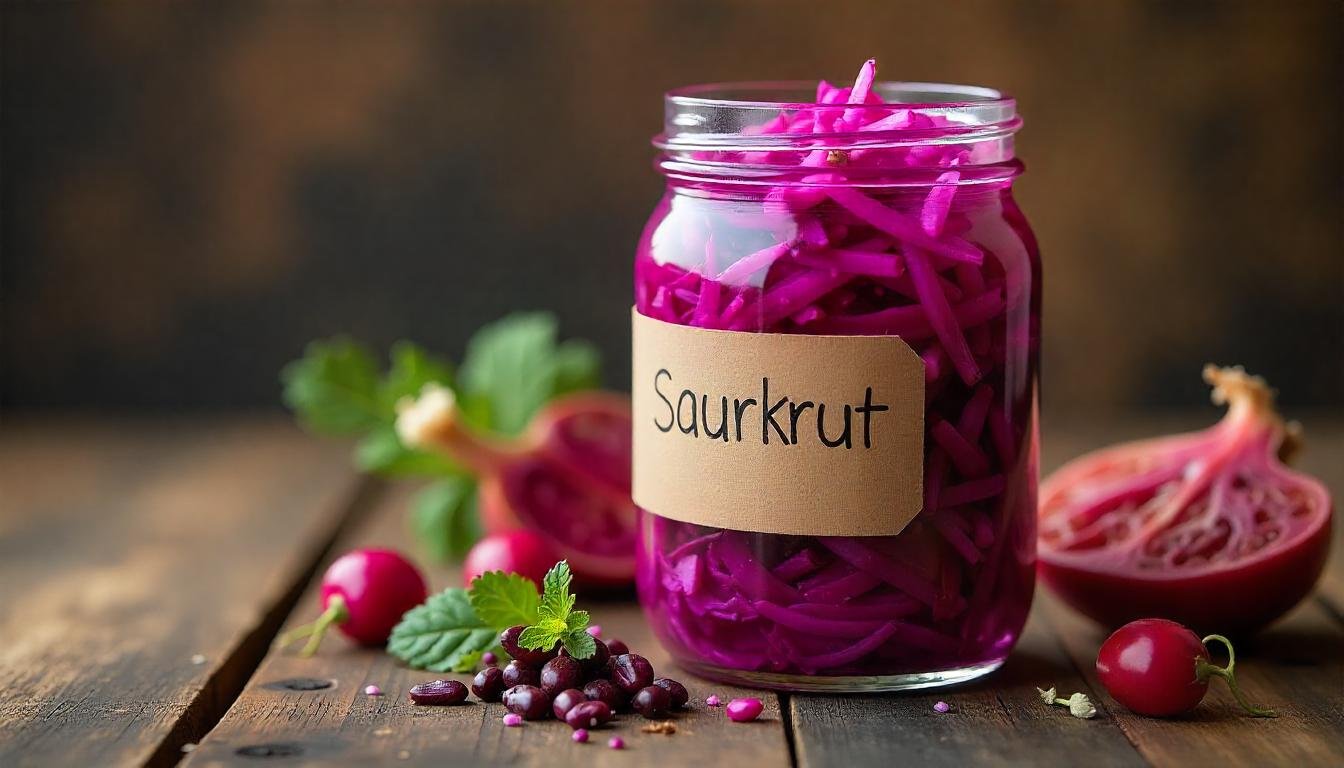Welcome to my kitchen, where I believe the simplest ingredients can become the most transformative foods for our health and happiness. Today, I’m thrilled to share my personal journey into crafting DIY probiotic-rich sauerkraut recipes—from my very first jar to my favorite flavor experiments. If you’re searching for easy probiotic sauerkraut, homemade sauerkraut recipes, or fermented cabbage benefits, you’ve landed in the right place.
Fermented foods are a culinary bridge across cultures, spanning continents and centuries. From tangy kimchi in Korea to creamy kefir in the Caucasus, fermentation preserves foods while layering in complex flavors and gut-loving probiotics. Sauerkraut—simply cabbage, salt, and time—offers an earthy tang, satisfying crunch, and a powerhouse of nutrients. Ready? Let’s dive into why homemade DIY fermented vegetables will revolutionize your kitchen.
Table of Contents
The Rich History & Cultural Context of Sauerkraut
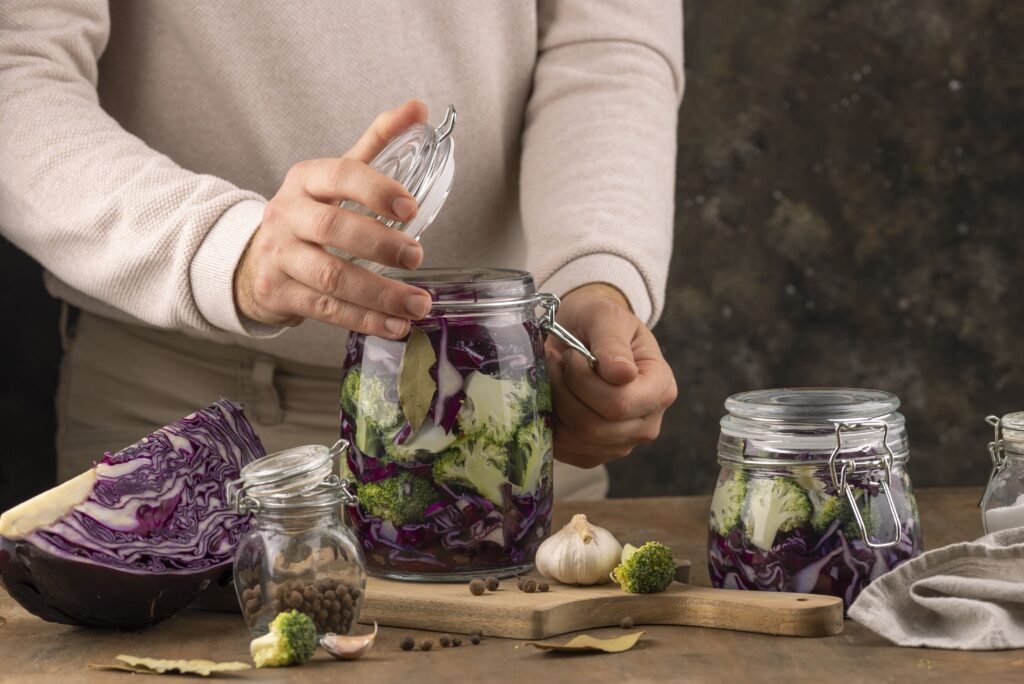
Sauerkraut’s heritage is a flavorful tapestry woven through time:
- Ancient China (circa 1000 BCE): Early records note salted cabbage preserved to prevent scurvy on long journeys¹.
- Marco Polo’s Travels (13th century): It’s believed he introduced cabbage fermentation techniques to Europe.
- Medieval Europe: Monasteries across Germany and France refined sauerkraut, adding juniper berries and spices for flavor and preservation.
- Sailor’s Staple (18th century): British Royal Navy adopted it to combat scurvy, earning cabbage the nickname “sea pickle.”
Regional Innovations:
- Germany: Classic caraway-seed kraut served with sausages and hearty stews.
- Alsace (France): Choucroute garnie—fermented cabbage slow-cooked with pork belly, saucisson, and potatoes.
- Eastern Europe: Varieties like Ukrainian burachky (beet kraut) and Polish kapusta kiszona with mushrooms.
- Baltic States & Scandinavia: Mixed with pickled herring for winter salad traditions.
This mosaic of cultural contexts inspires us to honor tradition while forging new paths in flavor.
Why Homemade Sauerkraut Triumphs Over Store-Bought
While store-bought sauerkraut may offer convenience, it often sacrifices flavor, probiotic potency, and ingredient integrity in the process. Here’s why taking the homemade route truly shines:
- Economical & Sustainable: A head of cabbage costs under $1 and yields multiple jars—far cheaper than probiotic supplements. You also reduce packaging waste, eliminate transport emissions, and upcycle kitchen scraps (like cabbage cores for veggie stock).
- Ingredient Transparency: You control every component—no added sugars, no synthetic preservatives, and complete freedom to choose organic, locally sourced produce. Plus, you’re free to experiment with herbs, spices, and superfoods tailored to your health goals.
- Superior Probiotic Counts: Unlike many commercial krauts—which are pasteurized, killing beneficial microbes—your homemade ferments remain raw, vibrant, and teeming with life. Home-fermented kraut often contains 10–100× more live cultures per gram than commercial counterparts².
- Flavor Freedom: Want it fiery, herbaceous, or tangy-sweet? You’re the boss. Blend in beets, turmeric, jalapeños, or even lemon zest—no factory formula can compete with your creativity.
- Personal Empowerment: Fermenting food fosters a deeper connection to your meals. There’s something grounding and rewarding about watching a humble vegetable transform into a probiotic powerhouse over days.
Pro Tip: Save brine from your best batches—it makes a fantastic starter culture, salad dressing base, or even a gut-friendly shot in the morning!
Advanced Fermentation Science: Beyond the Basics
Fermentation unfolds in predictable microbial stages:
- Early Stage (Days 1–3): Leuconostoc mesenteroides produces mild acids and CO₂, creating initial tang and a slight effervescence.
- Mid Stage (Days 3–7): Lactobacillus plantarum grows robustly, driving pH down to 4.0–4.2.
- Late Stage (Days 7+): Acid-resistant Lactobacillus brevis can increase complexity, adding subtle fruity esters.
Pro Tips for Precision Fermentation:
- Temperature Control: 68–72°F yields balanced tanginess. Cooler ferments slower with milder flavor; warmer accelerates acidity but risks mushiness.
- pH Monitoring: Aim for 3.8–4.2. Below pH 3.5, flavors can become overly sharp; above pH 4.5, risk of spoilage rises.
- Salinity Nuances: 1.5% salt favors faster fermentation and softer kraut; 2.5% yields crisper texture but slower acidification.
Essential Ingredients & Equipment Checklist
Making sauerkraut at home doesn’t require fancy tools, but a few thoughtful choices can elevate your process from basic to blissful. Here’s everything you need for optimal results and flavor depth:
Key Ingredients
- Cabbage: Green is the classic choice, but red or Napa cabbage adds variety. Always opt for firm, fresh heads with tight leaves.
- Salt: Use non-iodized salt such as sea salt, kosher salt, or Himalayan pink salt—iodine can inhibit fermentation.
- Optional Vegetables: Add carrots for sweetness, beets for color, or apples for a tart twist. Thin slicing ensures even fermentation.
- Flavor Boosters:
- Spices: Caraway seeds, mustard seeds, coriander
- Aromatics: Garlic, ginger, onions
- Herbs: Dill, rosemary, thyme
- Superfoods: Turmeric, lemon zest, juniper berries
Quick Pro Tip: Always toast spices like mustard or caraway seeds before adding—they release oils that amplify aroma.
Salting Methods
- Dry Salt Method: Sprinkle salt directly on shredded cabbage and massage to release natural brine.
- Brine Method: For whole leaves or thick slices, submerge in a pre-mixed saltwater brine (1 tbsp salt per 2 cups water).
Recommended Equipment
- Cutting Tools: Sharp chef’s knife or mandoline for even shredding.
- Mixing Bowl: Large enough for tossing and massaging your veg.
- Fermentation Vessels:
- Glass Jars: Ideal for small batches—easy to sterilize and observe.
- Ceramic Crocks: Great for large batches—stable temp and opaque material helps preserve quality.
- Fermentation Weights: Press veg beneath brine; use glass weights, clean river stones, or even a water-filled zip-top bag.
- Lid Systems:
- Airlock Lids: Minimize risk of mold and off-gassing buildup.
- Cloth + Rubber Band: A breathable DIY solution—just monitor more closely.
- Kitchen Scale: Essential for accurate salt percentage (typically 2% by weight).
Anecdote: I once used a clean, sanitized rock from my garden as a weight in a pinch—my grandmother swears by it to this day!
With this checklist, your sauerkraut setup is ready to go—efficient, safe, and optimized for maximum probiotic punch.
Classic Base Recipe (1 Quart Jar)
- Prep & Shred: Core and shred 2 lbs of cabbage (~900 g).
- Salt & Massage: Add 18 g salt (2%) and massage for 5–8 minutes until glossy brine appears.
- Pack & Weight: Press cabbage into jar, fill with brine to 1″ above shreds, add weight.
- Cover & Ferment: Seal and ferment 7–21 days at 68–72°F. Taste at intervals.
- Refrigerate: Once desired tang reached, seal with lid and chill—lasts up to 6 months.
Easy Sauerkraut Recipes:
1. Carrot & Ginger Glow Sauerkraut
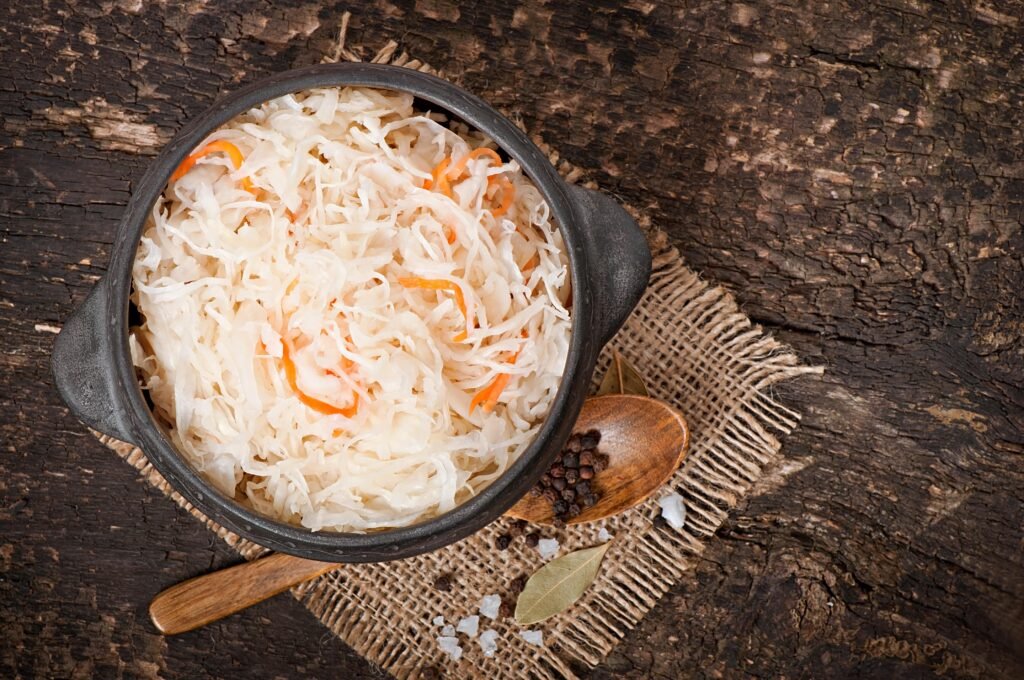
Expanded Flavor Profile: The sweetness of fresh carrots harmonizes with sharp, peppery ginger, while turmeric adds a subtle earthy warmth and golden hue. A pinch of black pepper elevates turmeric’s benefits.
Additions:
- 1 large carrot, shredded
- 1½” ginger root, finely grated
- 1 tsp turmeric powder
- ¼ tsp freshly cracked black pepper
Pairings & Serving:
- Roasted Fish & Veggies: Bright glow kraut cuts through rich oils of salmon or mackerel.
- Spiced Grain Bowls: Toss with quinoa, chickpeas, and avocado for a vibrant lunch.
- Warm Soups: Stir into carrot-ginger soup right before serving for added acidity and texture.
2. Spicy Kimchi-Inspired Sauerkraut
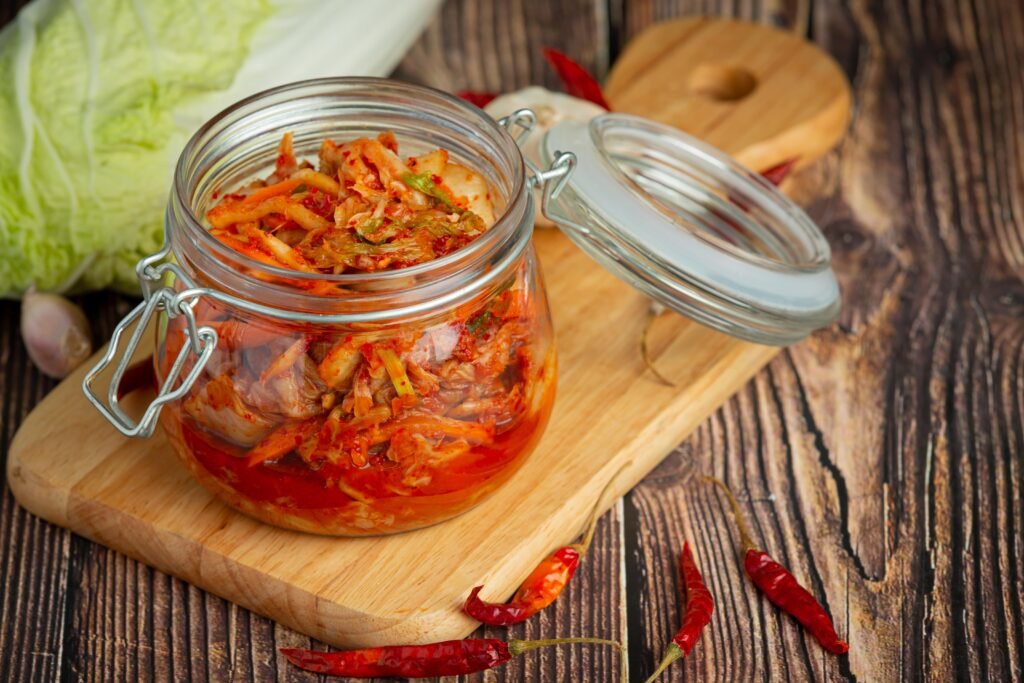
Expanded Flavor Profile: Kombines the earthiness of cabbage with the umami depth of fish sauce, the sharp bite of garlic and scallion, and a controlled heat from gochugaru. Fermentation mellows initial spice into a complex, rounded heat.
Additions:
- 2 tbsp gochugaru
- 3 scallions, chopped
- 4 garlic cloves, minced
- 1 tbsp fish sauce (sub tamari for vegan)
- 1 tsp grated ginger for brightness
Pairings & Serving:
- Bulgogi Tacos: Layer spicy kraut atop marinated beef or mushrooms.
- Ramen Bowls: Add as a garnish for heat and tang in miso or tonkotsu broth.
- Grilled Cheese Upgrade: Melt sharp cheddar over sourdough, top with a spoonful of kimchi-kraut for an epic flavor contrast.
3. Beet & Apple Sweet Sauerkraut
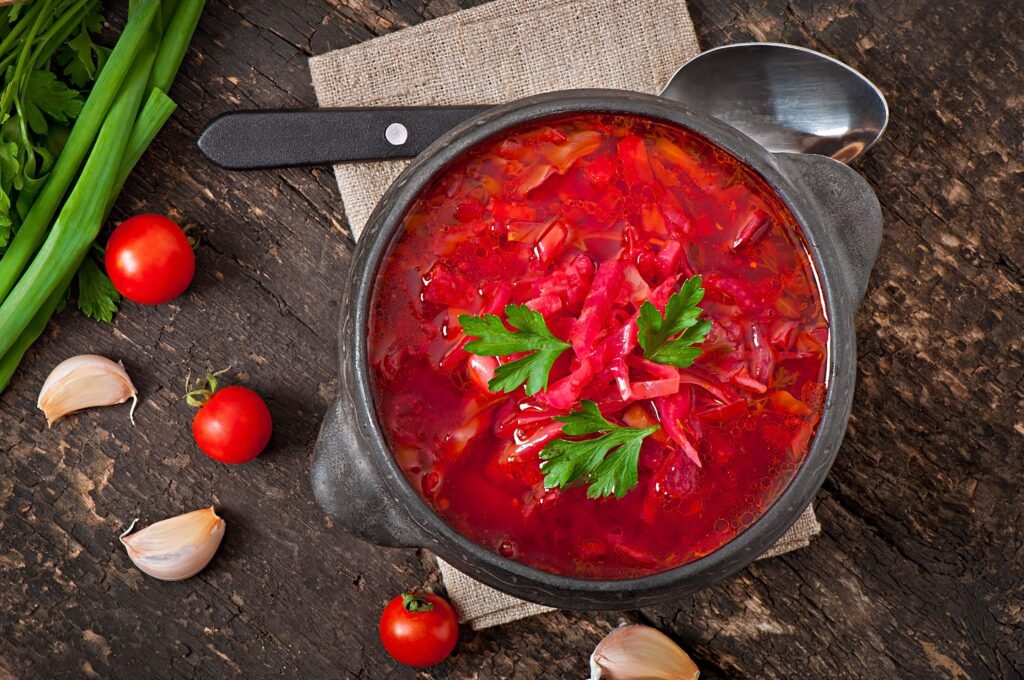
Expanded Flavor Profile: Earthy beets impart a subtle sweetness and deep crimson color, balanced by crisp tartness of Granny Smith apples. Caraway and cinnamon introduce aromatic warmth and complexity.
Additions:
- 1 small raw beet, shredded
- 1 medium Granny Smith apple, julienned
- 1 tsp caraway seeds, toasted
- ½ tsp ground cinnamon
- Zest of half a lemon for brightness
Pairings & Serving:
- Pork Loin or Chops: Classic pairing—sweet kraut complements savory pork.
- Holiday Charcuterie: Contrast with creamy brie or blue cheese.
- Colorful Grain Salad: Toss into farro salad with arugula, feta, and walnuts.
4. Herb-Infused Gourmet Sauerkraut
Expanded Flavor Profile: Fresh dill and rosemary lend a fragrant, piney character, while mustard seeds add gentle spice and juniper berries inject a resinous, slightly sweet note.
Additions:
- 2 tbsp fresh dill, chopped
- 1 sprig rosemary, finely minced
- 1 tbsp mustard seeds, lightly crushed
- 6 juniper berries, crushed
- 1 bay leaf, torn
Pairings & Serving:
- Smoked Salmon Platter: Bright kraut cleanses palate between bites.
- Herb-Roasted Potatoes: Mix into warm spuds with a drizzle of olive oil.
- Charred Vegetable Sandwich: Spread on grilled eggplant and zucchini for a sophisticated vegetarian bite.
Sauerkraut Uses & Creative Dishes
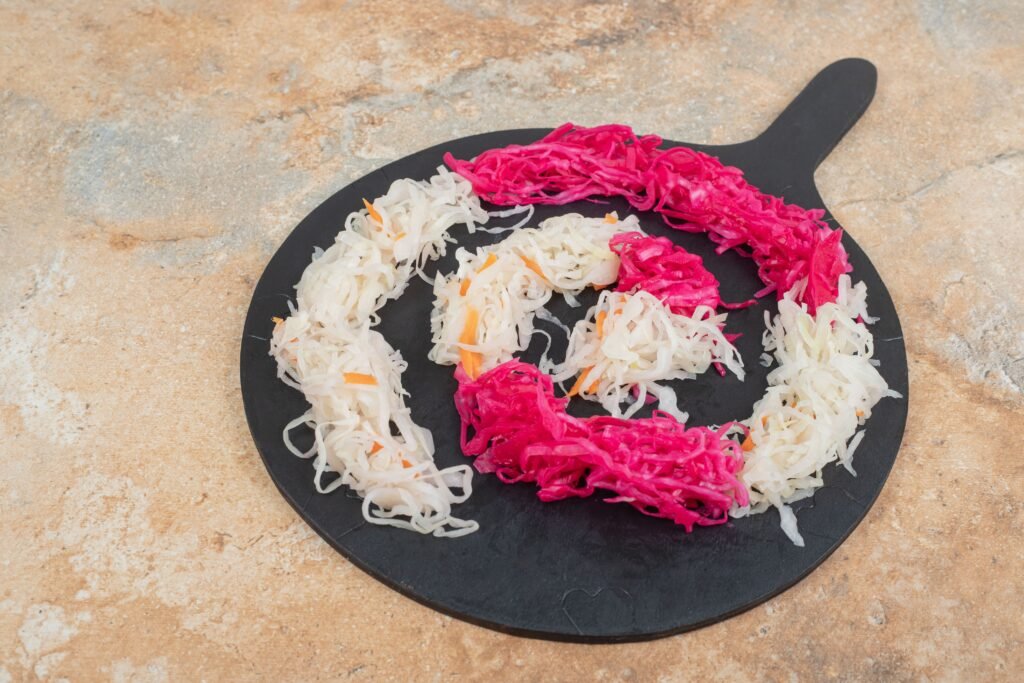
- Creamy Sauerkraut & Avocado Dip: Blend sauerkraut with ripe avocado, lime juice, garlic powder, and a drizzle of olive oil—serve with tortilla chips.
- Rainbow Kraut Slaw: Combine classic sauerkraut with shredded purple cabbage, carrots, bell peppers, and a honey-mustard vinaigrette.
- Savory Sauerkraut Pancakes: Fold sauerkraut into buckwheat pancake batter; serve with smoked salmon and crème fraîche.
- Probiotic-Packed Smoothie Booster: Stir a spoonful of sauerkraut (brine and all) into vegetable-based smoothies for a gut-health kick.
- Fermented Mustard & Kraut Dressing: Mix ¼ cup sauerkraut, 2 tbsp fermented mustard, 1 tbsp honey, and vinegar for a tangy salad dressing.
- Global Fusion Tacos: Swap salsa for spicy kimchi-kraut on fish or jackfruit tacos.
- Brussels Sprout & Kraut Hash: Sauté sprouts, potatoes, and sauerkraut with rosemary for a savory breakfast hash.
Each idea highlights sauerkraut’s versatility—experiment freely.
Troubleshooting & Advanced Tips
| Issue | Likely Cause | Detailed Solution |
|---|---|---|
| No visible brine | Low humidity cabbage, under-salting | Massage longer; add 2–3 tbsp brine (1 tbsp salt per cup water) after 10 minutes of massage. |
| Surface mold | Air exposure, contaminated tools | Skim mold immediately; rinse off top ½” of kraut; ensure weights keep all shreds submerged. |
| Excess fizz & haze | Rapid fermentation, warm temp | Move to cooler spot; open airlock daily to release CO₂; stir gently if too frothy. |
| Mushy texture | High temp/long ferment | Ferment at 60–68°F; check at day 5–7; salt at 2% for crisper bite. |
More Quick Pro Tips & Anecdotes
- Glass vs. Ceramic: Glass jars let you observe brine levels; ceramic crocks maintain stable temps.
- Sunlight Strategy: Ferment in indirect morning light—gentle warmth without UV.
- Flavor Journaling: Keep a fermentation log: dates, temps, add-ins, tasting notes. Over time, you’ll hit perfection every batch.
- Double-Brining: For extra crispness, pump brine into packed kraut with a clean turkey baster.
- Kombucha Crossover: Use kombucha SCOBY tea as part of brine for novel vinegar-acid profiles.
Conclusion
Creating DIY probiotic-rich sauerkraut blends art and science, history and innovation. From ancient voyages to modern kitchens, sauerkraut unites communities through flavor and wellness. Dive in, experiment, and let each crunchy mouthful remind you: simple ingredients, given time and care, can yield extraordinary health and joy.
Grab a head of cabbage, pick your favorite add-ins, and ferment your way to vibrant gut health—one jar at a time!
Happy fermenting!
FAQs: In-Depth Answers
Q: Can I reuse my brine as a starter?
Yes—reserve a few tablespoons from a successful batch to inoculate your next jar. This jumpstarts LAB growth, akin to sourdough discard.
Q: What’s the best way to flavor large batches?
Use separate crocks or large jars; reserve a small test jar for each variation to fine-tune seasoning before scaling up.
Q: Are there any contraindications for probiotics?
Most people benefit, but those with histamine intolerance may react to fermented foods. Start with small servings (1 tbsp) and monitor reactions.
Q: How do I transport sauerkraut safely?
Fill jars leaving minimal headspace; use airlock lids and pack upright in insulated cooler if traveling. Short trips are fine at room temp.
Q: Can I speed up fermentation?
Warmer temperatures (72–75°F) accelerate acidification but may compromise crunch. Consider using a fermentation heater pad set to 68°F for precision.
